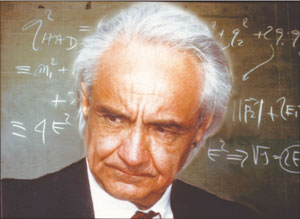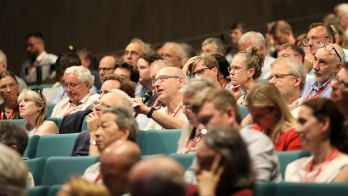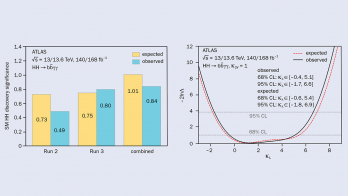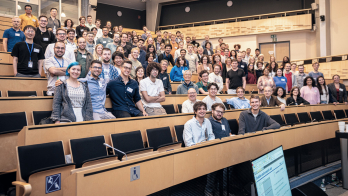This autumn, commissioning should be in full swing on the LHC at CERN, the world’s largest laboratory for the study of subnuclear physics. So it is entirely appropriate that the 46th Course of the International School of Subnuclear Physics, the oldest of the 123 schools of the Ettore Majorana Foundation and Centre for Scientific Culture (EMFCSC) in Erice, will look at what may come from the LHC – both the expected and the unexpected.
This year’s course, directed by Antonino Zichichi and Gerardus ’t Hooft, is to be held in Erice in September. It will provide the perfect opportunity to focus on the highlights from CERN, and in particular the goals of the LHC. This was also the theme of the 45th in the series, held in 2007, when CERN’s director-general, Robert Aymar, stated that these goals “could determine the future course of high-energy physics and should allow us to go beyond the Standard Model”.

Image credit: EMFCSC.
Physics beyond the Standard Model first appeared before the Standard Model itself, when Raymond Davis observed neutrinos from the Sun in the 1960s. At Erice last year, Alessandro Bettini from the Galileo Galilei physics department at Padua University pointed out: “From 1962 neutrinos were used to look into the Sun’s core, but their behaviour was totally unexpected.” This led to the case for neutrino oscillations – a phenomenon that the Italian Laboratori Nazionali Gran Sasso (LNGS) is studying through the CERN Neutrinos to Gran Sasso project, which started in August 2006. “The observation of neutrino oscillations has now established beyond doubt that neutrinos have mass and mix,” claimed Eugenio Coccia, director of LNGS, during his talk. “This existence of neutrino masses is the first solid experimental fact requiring physics beyond the Standard Model.”
The physics of neutrinos is also linked to the unseen matter of the universe. In 1933, Fritz Zwicky, on measuring the mean quadratic velocity of galaxies, proposed the existence of a kind of “invisible matter” – he named it dark matter – that could have neither electromagnetic nor strong nuclear interactions. Neutrinos became the obvious candidates for dark-matter particles, but the study of the evolution of large-scale structures in the universe has unexpectedly shown that the contribution of neutrinos must be extremely small, if it exists at all. Indeed, no Standard Model particle can be considered as the dominant component of dark matter. One new particle candidate is the sterile neutrino, as Lisa Randall from Harvard University explained last year. “This new ‘flavour’ of neutrino could be trapped, like gravitons, in a different brane from the one we live on,” she said. “For this reason we have not observed it directly so far. But the LHC should manage to see many particles that were created during the dawn of the universe and disappeared soon after the Big Bang.”
There are many questions in particle physics that the LHC could help to solve, which the 46th course will again discuss this year. A key question is whether the expectations from the LHC predictable.
To answer this, during his talk at the 45th course, Zichichi recalled a front-line scientist of the 20th century, whose birth centenary was celebrated last year at the World Nuclear Physics Conference in Tokyo. In 1935 Hideki Yukawa proposed the existence of a particle with a mass between that of the light electron and the heavy nucleon – the first meson. “No-one was able to predict the ‘gold mine’ hidden in the production, decay and intrinsic structure of the Yukawa particle,” said Zichichi. “This gold mine is still being explored today, and its present frontier is the quark–gluon-coloured world.” Zichichi also pointed out: “It is considered standard wisdom that nuclear physics is based on perfect theoretical predictions, but people forget the impressive series of unexpected events with enormous consequences [UEEC] discovered inside the Yukawa gold mine.”.
Such UEEC events are a common feature of the greatest scientific discoveries and the most important historical facts. However, there is a difference. Analysing history on the basis of “what if?” leads historians to conclude that the world would not be as it is if one or any number of “what if?” events had not occurred. This is not the case for science, as Zichichi underlines: “The world would have exactly the same laws and regularities, even if Galileo Galilei or somebody else had not made their discoveries.”
UEEC events will be crucial evidence for understanding the existence of complexity at the elementary level. “No one could predict a UEEC event on the basis of present knowledge,” Zichichi pointed out. “In fact predictions are based on the mathematical description of UEEC events, so they come only after a UEEC event. Moreover, we should be prepared with powerful experimental instruments, technologically at the frontier of our knowledge, to discover all the pieces of the Yukawa gold mine.”
With the advent of the LHC at CERN, a new supercollider will study the properties of a “new world” produced in collisions between heavy nuclei (208Pb82+) at the maximum energy so far available (1150 TeV). This world is the quark–gluon-coloured world, totally different from all that we have so far been dealing with.
As Aymar underlined: “If new physics is there, the LHC should find it.” There is nothing left for us but to await the unexpected.








